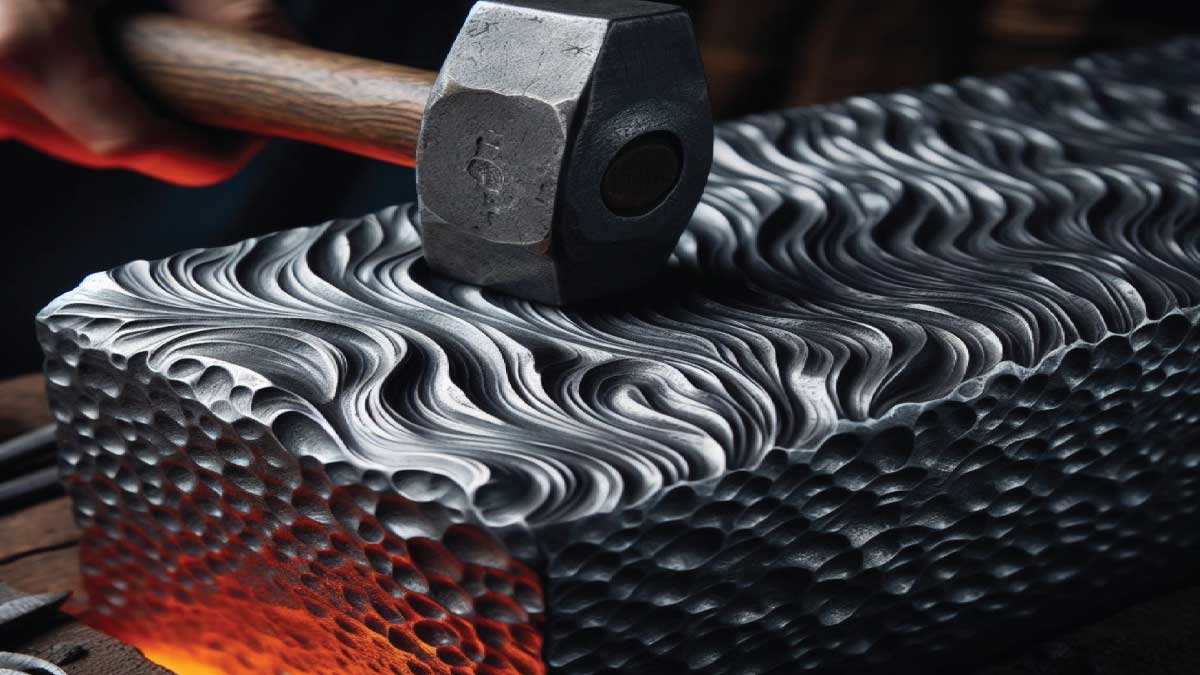Forged steel refers to metal that has been heated and shaped under intense pressure, typically using a hammer or press. This process refines the steel’s grain structure, enhancing its strength, durability, and overall performance.
Forged steel stands as a testament to human ingenuity and innovation, a material forged in the fires of progress to meet the demands of modern industry. In this extensive exploration, we delve deep into the realm of forged steel, uncovering its origins, unraveling its manufacturing process, examining its myriad applications, and elucidating its advantages over alternative materials.
The Genesis of Forged Steel
Forged steel traces its roots back to ancient civilizations, where blacksmiths honed their craft to fashion tools and weapons from raw metal. The art of forging involves heating metal to high temperatures and shaping it through repeated hammering or pressing, a process that imparts strength, resilience, and durability to the finished product. Over the centuries, advancements in metallurgy and technology have refined the forging process, giving rise to the modern marvel that is forged steel.
Understanding the Manufacturing Process
The manufacturing process of forged steel is a fascinating journey, where raw metal undergoes a transformation akin to alchemy, emerging as a masterpiece of engineering. This intricate process, characterized by heat, pressure, and precision, unfolds in stages that blend artistry with scientific rigor.
Heating:
The saga commences with the raw steel being ushered into the fiery embrace of a furnace, where temperatures skyrocket to thousands of degrees Fahrenheit. In this crucible of heat, the metal sheds its rigidity, becoming pliable and receptive to the shaping that lies ahead. It’s a moment of metamorphosis, where the steel’s innate potential begins to stir, laying the foundation for its eventual form.
Forging:
As the steel reaches its optimal temperature, it is ushered onto the stage of forging, where immense forces come into play. Here, the metal encounters hammers that thunder down with controlled fury or presses that exert steady, unyielding pressure. With each strike or compression, the steel yields to the shaping hands of the craftsmen, gradually assuming the contours of its intended design. This phase is where the true artistry of forging shines, as skilled hands guide the metal through a dance of transformation, coaxing it to embody strength, resilience, and grace.
Cooling:
Having been molded and shaped to perfection, the forged steel emerges from the crucible of forging, its form defined and its potential unleashed. But the journey is far from over. To temper its newfound strength and fortitude, the steel must undergo a process of controlled cooling. Like a warrior quenching its blade, the steel is carefully immersed in baths or subjected to carefully regulated environments, allowing its molecular structure to settle and stabilize. This tempering not only enhances the steel’s physical properties but imbues it with a resilience that will withstand the trials it is destined to face.
Finishing:
With its strength honed and its character tempered, the forged steel enters the final act of its transformation – the stage of finishing. Here, the focus shifts from raw power to refined elegance as the steel undergoes meticulous machining, grinding, and polishing. Every surface is scrutinized, every dimension measured with precision, as artisans work to achieve the desired aesthetic and functional qualities. It’s a process that demands patience and attention to detail, for the smallest imperfection can mar the beauty of the final piece. But with skilled hands and unwavering dedication, the forged steel emerges from this crucible of refinement, resplendent in its glory, a testament to the mastery of its creators.
Applications Across Industries
Forged steel stands as a stalwart ally across an array of industries, its versatility and durability rendering it indispensable where precision and reliability reign supreme.
Automotive:
In the fast-paced world of automotive engineering, forged steel takes center stage, lending its formidable strength and durability to critical components that bear the brunt of mechanical stress. Within the heart of engines, forged steel crankshafts spin with unwavering precision, translating explosive combustion into smooth, controlled motion. Connecting rods, subjected to relentless cycles of compression and tension, rely on the resilience of forged steel to maintain structural integrity, ensuring engines run with unwavering efficiency.
Gears, the silent orchestrators of vehicular movement, mesh with precision thanks to the reliability of forged steel, transmitting power with minimal loss and maximal dependability. In the automotive realm, where safety and performance are paramount, forged steel stands as an unwavering sentinel, ensuring vehicles traverse the roads with confidence and assurance.
Aerospace:
In the boundless expanse of the sky, where every ounce matters and every component is pushed to its limits, forged steel emerges as a stalwart companion to aviation’s pioneering spirit. Within the sleek fuselages of aircraft, forged steel components bear the weight of human ingenuity, their lightweight yet robust properties defying gravity’s grasp. Landing gear, the unsung heroes of aerial travel, touch down with grace and precision, thanks to the resilience of forged steel, absorbing the impact of touchdown without faltering.
Engine mounts, subjected to the relentless roar of jet propulsion, stand firm against the forces of thrust and turbulence, anchored by the strength of forged steel. Structural elements, spanning the wings and fuselage, provide the framework for flight, their forged steel frames bearing the weight of dreams as they soar through the heavens.
Construction:
On the solid ground below, forged steel lays the foundation for modern civilization, its strength and resilience shaping the skylines of cities and the arteries of commerce. Structural steel, forged from alloys of unparalleled quality, forms the backbone of towering skyscrapers, their steel frames reaching for the heavens with unwavering resolve. Bridges, spanning chasms and rivers, owe their longevity to the durability of forged steel, standing as testaments to human engineering prowess. Highways, threading through landscapes and connecting communities, rely on the strength of forged steel in their guardrails and support structures, ensuring safe passage for millions of travelers.
In the realm of construction, where safety and longevity are paramount, forged steel stands as an enduring symbol of progress and possibility.
Manufacturing:
Within the bustling confines of manufacturing facilities, forged steel reigns supreme, its reliability and longevity powering the machinery and tools that drive global commerce. From towering presses to precision lathes, forged steel components form the backbone of industrial operations, their unwavering strength ensuring smooth, uninterrupted production. Shafts and bearings, subjected to punishing loads and high speeds, rely on the resilience of forged steel to maintain precision and performance. Dies and molds, shaping raw materials into finished products, owe their longevity to the durability of forged steel, standing up to the rigors of repetitive use with unmatched resilience.
In the world of manufacturing, where efficiency and productivity are paramount, forged steel stands as a steadfast ally, ensuring the wheels of industry turn without faltering.
Advantages of Forged Steel
Forged steel stands as a paragon of engineering excellence, its superiority not merely confined to its formidable strength and durability, but also extending to a myriad of advantages it holds over alternative materials, establishing itself as the material of choice across diverse industries.
Exceptional Strength:
At the heart of forged steel’s supremacy lies its unmatched strength and toughness, qualities that set it apart from cast or machined counterparts. Through the transformative process of forging, the molecular structure of steel is refined and strengthened, resulting in components capable of withstanding the most punishing stresses and loads. Whether tasked with supporting the weight of skyscrapers or enduring the relentless forces within machinery, forged steel stands as a bastion of reliability and resilience, ensuring optimal performance even in the face of adversity.
Enhanced Reliability:
Forged steel’s superiority extends beyond sheer strength to encompass a level of reliability and consistency that is unmatched by other materials. Thanks to its dense grain structure and the absence of internal defects commonly found in cast components, forged steel offers engineers a level of confidence unrivaled by its counterparts. This inherent reliability translates to consistent operation and prolonged service life, vital attributes in industries where downtime is not an option and failure is not an acceptable outcome.
Customizability:
One of the most significant advantages of forged steel lies in its inherent customizability, made possible by the precise control afforded by the forging process. Engineers have the freedom to tailor the properties of forged steel components to meet the exacting requirements of their designs with unparalleled accuracy. Whether it’s adjusting hardness, optimizing strength-to-weight ratios, or fine-tuning dimensional tolerances, forged steel offers a level of versatility that is simply unparalleled. This ability to craft bespoke solutions ensures that every component is perfectly suited to its intended application, maximizing performance and efficiency while minimizing waste and excess.
Cost-Effectiveness:
While the initial investment in forged steel components may be higher compared to alternatives, the long-term benefits far outweigh the upfront costs. Thanks to its superior strength, reliability, and longevity, forged steel components offer unparalleled value for money over their operational lifespan. Reduced maintenance requirements, extended service intervals, and minimal downtime contribute to significant cost savings over time, making forged steel the discerning choice for budget-conscious industries. In essence, while the initial outlay may be higher, the return on investment offered by forged steel is unmatched, making it a wise and cost-effective choice in the long run.
Related Posts:
7 Key Differences Between Forging and Casting
7 Easy Steps to Understand the Casting Process
Learn About Casting: A Very Easy and Simple Guide
Conclusion
In conclusion, forged steel stands as a testament to human craftsmanship and engineering prowess, offering unparalleled strength, durability, and reliability across a myriad of industries. From automotive to aerospace, from construction to manufacturing, the applications of forged steel continue to expand as industries seek high-performance solutions to meet the challenges of the modern world. By understanding the origins, manufacturing process, applications, and advantages of forged steel, businesses can unlock the full potential of this remarkable material and forge a path to success in the competitive landscape of today’s industries.
FAQs:
What is the forging process for steel?
The forging process for steel involves heating the metal to high temperatures and then shaping it under compressive force, typically using a hammer or press. This process refines the steel’s grain structure, enhancing its strength and toughness.
What are some common applications of forged steel?
Forged steel finds widespread use in industries such as automotive, aerospace, construction, and manufacturing. It is commonly used for critical components like crankshafts, connecting rods, gears, landing gear, engine mounts, structural elements, and heavy machinery.
What are the advantages of using forged steel over other materials?
Forged steel offers exceptional strength, reliability, and durability compared to alternatives like cast or machined components. Its dense grain structure and absence of internal defects ensure consistent performance under high stresses. Additionally, forged steel can be customized to meet specific design requirements with precision, and while the initial cost may be higher, its extended lifespan and reduced maintenance make it a cost-effective choice in the long run.
Is forged steel more expensive than other materials?
While the initial cost of forged steel components may be higher compared to alternatives, such as cast or machined parts, the long-term benefits often outweigh the upfront investment. With its superior strength, reliability, and longevity, forged steel components offer significant cost savings over their operational lifespan due to reduced maintenance requirements and extended service intervals.
How does the quality of forged steel affect its performance?
The quality of forged steel directly impacts its performance and durability. High-quality forged steel undergoes rigorous quality control measures to ensure a uniform grain structure and absence of internal defects, resulting in components that exhibit exceptional strength, reliability, and consistency. Lower-quality forged steel may suffer from inconsistencies or defects that compromise performance and longevity.

HA Chaudhary is an experienced engineer with 15 years in the mechanical and industrial sectors. Holding advanced degrees and multiple certifications in engineering, he combines technical expertise with a passion for writing to provide valuable insights into engineering innovations and business strategies. His content empowers professionals to excel in their fields and stay updated with the latest industry trends.

